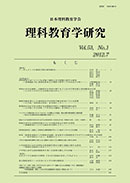Volume 47, Issue 1
Displaying 1-9 of 9 articles from this issue
- |<
- <
- 1
- >
- >|
Original Papers
-
2006 Volume 47 Issue 1 Pages 1-6
Published: July 31, 2006
Released on J-STAGE: June 30, 2022
Download PDF (723K) -
2006 Volume 47 Issue 1 Pages 7-16
Published: July 31, 2006
Released on J-STAGE: June 30, 2022
Download PDF (1194K) -
2006 Volume 47 Issue 1 Pages 17-23
Published: July 31, 2006
Released on J-STAGE: June 30, 2022
Download PDF (1210K) -
2006 Volume 47 Issue 1 Pages 25-34
Published: July 31, 2006
Released on J-STAGE: June 30, 2022
Download PDF (1940K) -
2006 Volume 47 Issue 1 Pages 35-43
Published: July 31, 2006
Released on J-STAGE: June 30, 2022
Download PDF (1044K) -
2006 Volume 47 Issue 1 Pages 45-58
Published: July 31, 2006
Released on J-STAGE: June 30, 2022
Download PDF (2302K) -
2006 Volume 47 Issue 1 Pages 59-67
Published: July 31, 2006
Released on J-STAGE: June 30, 2022
Download PDF (1119K) -
2006 Volume 47 Issue 1 Pages 69-74
Published: July 31, 2006
Released on J-STAGE: June 30, 2022
Download PDF (515K)
Note
-
2006 Volume 47 Issue 1 Pages 75-83
Published: July 31, 2006
Released on J-STAGE: June 30, 2022
Download PDF (908K)
- |<
- <
- 1
- >
- >|
